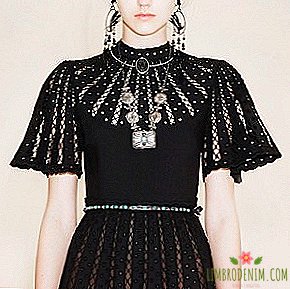"Woman's suit": Why do sportswomen still wear uncomfortable clothes?
THIS WEEK TENNISIST ALIZE KORNE, without leaving the court, changed clothes for a jersey during the US Open Championship match - and, to her surprise, received a warning from the judge. That, in turn, followed the long-standing rule, which the United States Tennis Association thought of after it was repealed. This case once again reminds us that women's sport still remains monstrously conservative, and the traditions and ideas about “femininity” that have outlived their time are still put above banal convenience.
First of all, it concerns sports dress code, which is quite paradoxical: the production of clothing for professional sports has long become an arms race, and yet there are entire disciplines where athletes still have to wear an uncomfortable shape and "women's suits." Why is this so?

Closed club
Ask your friends to draw (or at least describe in words) a tennis player, and in nine out of ten cases you will get a figure in a skirt. Despite the fact that there is no strict prescription to wear a skirt in modern women's tennis for a long time, and athletes from the first dozens of the WTA rankings regularly go to shorts, the stereotype continues to live.
“So accepted” is a universal explanation of any tradition that looks strange today, and tennis is no exception. The roots of tennis dress codes should be sought in the history of private clubs, from which modern tennis tournaments have grown. Many clubs have existed since the nineteenth century, when the standards of appearance were somewhat different (for example, women were often forced to play in corsets) and somewhat resemble closed schools. Albeit without a uniform pattern, but with very specific ideas about what style of clothing and what colors should be worn to its members - to be different from members of other clubs.
The most striking example in this sense is, of course, Wimbledon, with its strict color dress code. All participants of the tournament, who grew up in 1877 on the basis of the All-English Croquet Club and Lawn Tennis Club, are obliged to go to court in all white, and in white of certain shades - no cream. As an exception, logos of brands are allowed, as well as edging and single stripes with a width of less than a centimeter. The restriction dictated by the Victorian fashion was due to the fact that white clothes are less visible traces of sweat (and the sweat of a nineteenth-century British lady, of course, was forbidden). Already in the twentieth century, the rule was pretty much infuriated by male players - because of him Andre Agassi boycotted the tournament three years in a row, although he later surrendered - however, Wimbledon is not going to cancel it and jealously watches his execution.
However, this does not mean that tennis players fail to circumvent formal prohibitions, or even simply mock the Victorian code: for example, in 1985, in 1985, the organizers of the tournament angered the unitard overalls, in zero and ten sisters Williams protested against white colored wristbands bandages and manicures, and Bethany Mattek-Sands went to court in a designer suit, studded with stylized tennis balls. And, by the way, you should not write off the rules of major tournaments only as a tribute to traditions. After the same Williams went to the court, “Roland Garros” in the Nike costume, clearly inspired by the “Black Panther”, the French Tennis Federation said that henceforth, participants in the tournament in this form will not allow him to.
Princess Sports
Figure skating is another sport where riots against uncomfortable or just boring clothes happen regularly and resemble altercations about appearance with the school head teacher. So, after a double scandal at the Winter Olympics, when Katharina Witt stepped on the ice in the leotard, which opened her hips, and her rival, Debi Thomas, in a tight-fitting jumpsuit, the International Skating Union (ISU) made the skirt covering the hips, mandatory for figure skaters. In 2004, the “Katharina rule” was revised, allowing shorts and overalls in addition to skirts, and introduced a more general wording: yes - for “modest, decent and suitable for athletic competition” clothes, no - for everything that falls under the definition of “showy” “theatrical” or “unacceptable outcrop” (the latter, however, does not deter skaters from using flesh-colored costumes).
Although women's figure skating still has the image of the “sport of princesses”, the style of costumes in it does not have such a value that it is usually attributed to it. And if in the past, subjective marks for artistry were put up, among other things, for “presentable”, now judges are more interested in how athletes keep themselves on the ice than what they are wearing. At the same time, few people deny the existence of stereotypes of the “right skater” - they make themselves felt, even if they are not fixed at the level of rules. And of course, the performance of the French Mae Berenice Mayte, who skated the Olympic program under the medley of Beyonce songs (in leggings, we note), does not fit into this stereotype.
“Judges expect to see a certain type of girls, and if you don’t meet the type of a small pretty figure skater ... Well, you have to adjust to the judges,” skater Katrina Nelken argues. “You don’t want to stand out for clothes if you don’t have a cover [in the form of a complex program] It's easier to follow traditions. " "Many judges work for years, and many of them do not believe that a young girl or woman should not wear a dress. The dress is a traditional outfit," explains coach Rene Gelesinski.
Eye candy
One should not disregard the general disregard for women's sports, which, in turn, contributes to its sexualization: "If women cannot achieve high results, even if they look attractive." The former FIFA president, Sepp Blatter, clearly hinted at this in 2004, stating that women's football would become more popular if footballers played in "more feminine clothes, like in volleyball": "For example, they could wear more tight shorts." The view of Blatter, who was later dismissed due to corruption allegations, was not supported by women's football, but on the whole she illustrates well the traditional sexism in the world of sports.
This, in turn, is reflected in the design of clothes that athletes are forced to wear under contracts with brands. Sometimes this leads to embarrassment like what happened at the same Wimbledon two years ago. Then several tennis players at once complained about the inconvenience of the uniform, which Nike had made specially for the tournament: the short dresses of the free cut did not help the game too much. "When I served, it was heaving, and I had the feeling that the dress was flying everywhere," Rebecca Peterson shared her impressions. One of her colleagues, Katie Bulter, solved the problem by wrapping her dress with a headband, the other, Lucia Gradetskaya, could not stand it and forged leggings. Retrodesign has failed.
The good news is that although sexist traditions continually make themselves felt, in most sports, almost no one disputes the priority of convenience. The mutual benefits of comfortable sportswear are obvious: the more practical the form, the higher the athlete's chances of success, and the higher the achievement of the athlete, the better for the brand that wears it.
Photo: Galina Barskaya - stock.adobe.com, Library of Congress / Harris & Ewing Collection





